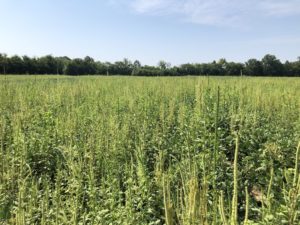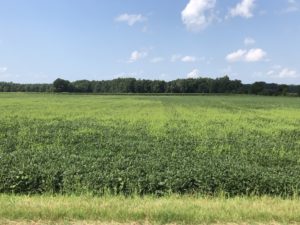More Dicamba Sprayed, Yet Weed Control Lags
Dr. Larry Steckel, Professor, Row Crop Weed Specialist with the University of Tennessee, chatted with CropLife on the growing concern of escalating weed escapes in Xtend fields.
Last August, you wrote about reports of Palmer amaranth weed escapes in Xtend crops continuing to mount, and that research conducted this winter would be able to confirm if resistance was the culprit. Where are you at with that testing?
The jury is still out for a couple of weeks. They just got sprayed last week, so we ought to know something mid-March. What I know is, this past year, we surveyed 75 Xtend fields where we had significant issues with weeds getting by dicamba applications in soybeans, and a little more than half of the time it was Palmer amaranth. That’s a new development.
Weed control (from dicamba mixed with glyphosate) was pretty good prior to 2019 on Palmer and with a few notable exceptions on grasses. This past year, about half the weed control complaints concerned poor Palmer amaranth control and better than 60% of the time dicamba mixed with glyphosate did not control barnyardgrass species. We haven’t seen this poor of weed control in Xtend crops over this widespread an area as we did this past year.
How bad was the suspected resistance you observed with Palmer in 2019? Was it worse than 2018?

Palmer amaranth in soybean escaping Engenia + Roundup applied on 2- to 4-in. Palmer. “It looked very similar to 2011 Roundup-resistant Palmer amaranth fields.” — Larry Steckel
Yes. It was a complete grown-out mess in some cases. Some of the fields reminded me of the first Roundup-resistant fields we walked 12 years ago, where it’s just choked up with pigweed. It looked very similar, so that really gets you thinking that it may be resistance. We had a very wet year, so maybe that’s part of the issue with how weeds are recovering. You could see on those plants that it wasn’t that dicamba wasn’t affecting the pigweed – it was. It was often taking out the main meristem. How Palmer recovered was via the lower lateral buds, even on pigweed that was sprayed very timely, at 2 to 4 inches in height, and well on label. You expect that on real big pigweed that gets away from folks, but not on small stuff. That was the difference this year.
How are growers managing the weed escapes?
We got back to chopping crews again – we kind of got away from that the last couple of years, but folks had them back out again this year. Some of these fields, I don’t think you could have gotten a combine through them. They tried, but they were just messes.
We’ve also heard about issues with dicamba control in grassweeds. Can you tell us more about that?

Junglerice/barnyardgrass escaping Engenia + Roundup followed by Engenia + Roundup. Photo credit: Larry Steckel
In 2012, we got some of the first calls that Roundup and (older formulations of) dicamba used as a burndown weren’t controlling the barnyardgrass complex. This has been building in the southwestern part of the state, around Memphis and the Hatchie River Bottom. We reached a tipping point this past year, where you could find control failures clear south of Nashville in significant levels.
In 2018, roughly 20% of junglerice/barnyardgrass was 8x resistant to Roundup, and another 20% was 6x resistant. The rest was either more susceptible to Roundup than our susceptible check, or up to two-fold resistant.
The reason for the lack of junglerice/barnyardgrass control on Roundup-susceptible populations is due to antagonism – where the dicamba is impeding the glyphosate from working on the grass. We did some follow-up studies with Clay Perkins, my graduate student, and found we’re still only getting 80% control with a quart of Roundup by itself. You put Engenia in the tank with Roundup, and it drops to 50% control.
The other components you’ve got to use in the Xtend system are also a factor. With TTI tips, you lose another 5% to 10% grass control from glyphosate, then with the drift reduction agents you add in, you lose another 10%. With the tank-mix used by label application methods, you’re essentially not going to get grass control on many of our fields now. A lot of farmers found out the hard way this year.
How much do the grassweeds impact yield?
They are very competitive. It’s in the realm of what you get with Palmer amaranth. As far as actual yield loss, in some of those fields where they’re really growing up in places it’s easily a 20% or 30% yield loss. Then, combines get choked up with grass, even in corn. Barnyardgrass species have similar, very quick growing characteristics to Palmer amaranth.
What recommendations are you making for improved grassweed control?
The big one going forward is, with this Xtend system, a lot of folks have been trying to get by with either not using a pre, or using something like a little metribuzin, and that’s really hurting us on the residual control. Keep the weeds from coming up, because from a postemergence standpoint, it’s a struggle and a big reason to keep using those pres.
I like pyroxasulfone-based products, like Zidua, Anthem, or Dual-based products. Start out with those, because they’re good on grasses and broadleaf weeds. Then postemergence, split up the applications. Spray your dicamba first and wait at least five days to try to do something with the grass. Our research would suggest you need at least 72 hours for the dicamba to work through the grass before you go out and spray it with Roundup or clethodim.
We’ve also been working on the issue with dicamba antagonizing clethodim grass control. For the most part, we’re finding that the grasses are still susceptible to clethodim, but if you mix it with dicamba it’s not working – it’s the same issue we’re having with Roundup. So, wait five days to get the dicamba to work through the grass, and then hit the grass weeds with glyphosate or clethodim.
The take-home: We’re not going to be able to do a one-pass spray of Roundup-dicamba, if we think we’re going to get good control of pigweed and grass weeds. It’s just not happening.
How much higher is this driving application costs?
Some of my cotton farmers this past year who sprayed a tank mix of Roundup plus dicamba didn’t get the grass so they sprayed it again with the same tank mix. They had to come back with a third pass, several weeks to two weeks later in some cases, with straight clethodim. Their herbicide costs doubled. That’s the new lay of the land.
And you’ve witnessed a growing weed escape issue in cotton fields?
It is affecting cotton, but the cotton label is easier, and so there is better weed control. Number one, with cotton you’ve got a 60-day spray cut-off. With soybeans, it’s R1, which is about 35 days. You use an effective pre, so the pigweed doesn’t come up for three weeks. So, you’ve got 14 days to get them managed with post applications. You can probably get them sprayed once, but to get good Palmer amaranth control in 2019 they often needed to be sprayed twice. In soybeans, you don’t have time for two post emergence applications of dicamba.
Plus, in cotton, you can spray Liberty, which is a really good clean-up product on pigweed that’s escaping dicamba. It isn’t that the pigweed isn’t affected by dicamba – it is, typically causing much slower Palmer amaranth growth. Liberty is really good at taking out escapes. That gives cotton an advantage that soybeans don’t have right now.
To your last point, Bayer has announced it will launch XtendFlex soybeans that will add glufosinate tolerance, pending EU import approval of the trait.
Getting Liberty tolerance into soybeans will help so we’re not just locked into spraying dicamba and Roundup, followed by dicamba and Roundup, because it’s clearly not very sustainable, at least here in Tennessee. This year, we’re going to have live with what we’ve got.
There is the grassweed issue, and now after ’19, you’re starting to scratch your head on Palmer amaranth, and also on prickly sida. We’re seeing a lot of it in many of these fields now – about three out of every 10 fields had it in 2019. Prickly sida is not on the Engenia label. Roundup never has been very good on it. You mix the two together, and it’s still not good on it. So, we’re seeing a good bit of problems with it as well.
What about Corteva Agriscience’s Enlist – do you see this new system being able to compete with Xtend in your area?
We’re at 97% Xtend in soybeans and better than 90% Xtend in cotton. Driving a lot of that in 2019, quite frankly, was seed supply. We are working in an age where these company programs basically lock you into using one technology. Financially, it typically just doesn’t make sense to do part of your crop in Xtend and part of it in Enlist. Plus, it’s just the spray tank clean-out issue. You’re all one technology or the other.
I don’t expect a lot of Enlist soybeans in 2020 due in part to seed supply issues of the higher-yielding Enlist varieties. In addition, many growers worry about dicamba drift onto their Enlist soybeans. For a lot of folks, that’s a deal-breaker right there.
Email the author at [email protected] with your comments and questions.






